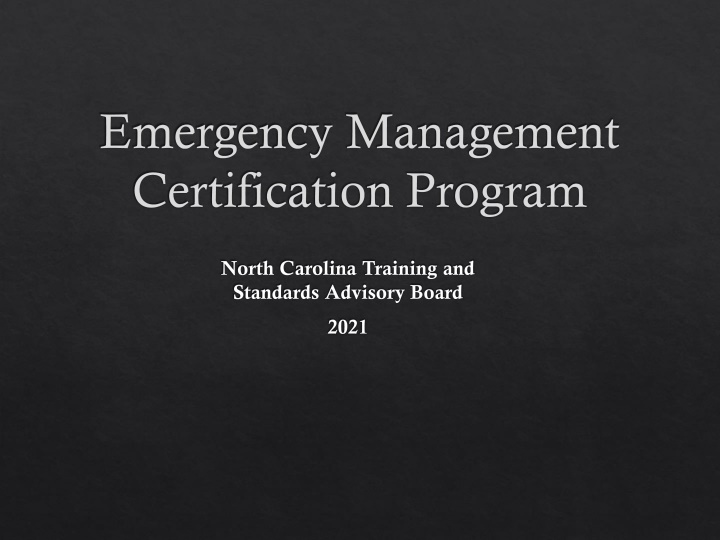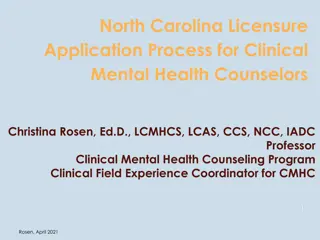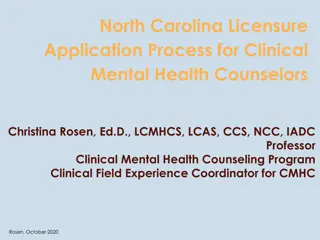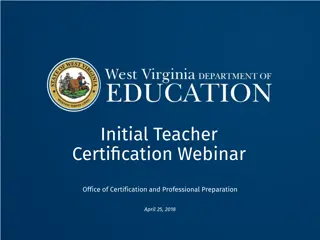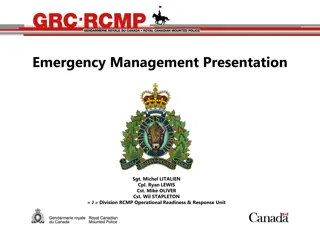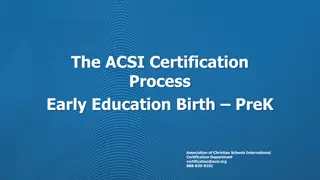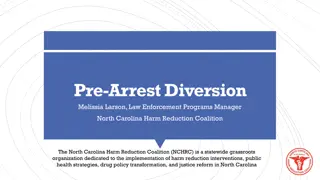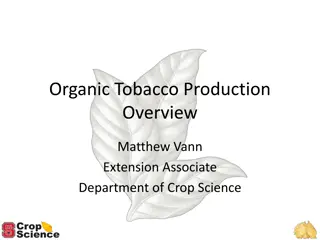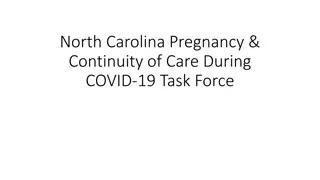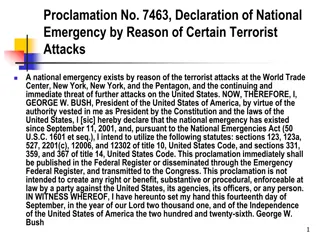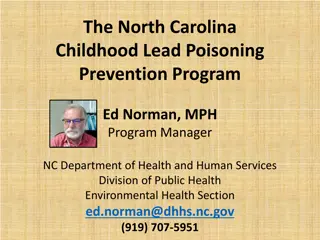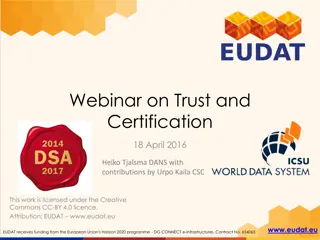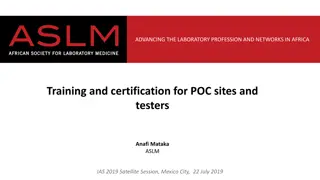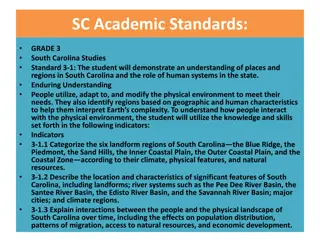Emergency Management Certification Program in North Carolina
The Emergency Management Certification Program by the North Carolina Training and Standards Advisory Board for 2021 entails a two-tiered process involving Associate and Executive Emergency Manager designations. Educational requirements range from a high school/GED for Associates to a Bachelor's degree or equivalent experience for Executives. Training requirements include specific hours in emergency and general management training, with restrictions on topic hours. The program allows for substitutions based on college degrees earned in related fields, determining hours based on years since completion.
Download Presentation

Please find below an Image/Link to download the presentation.
The content on the website is provided AS IS for your information and personal use only. It may not be sold, licensed, or shared on other websites without obtaining consent from the author.If you encounter any issues during the download, it is possible that the publisher has removed the file from their server.
You are allowed to download the files provided on this website for personal or commercial use, subject to the condition that they are used lawfully. All files are the property of their respective owners.
The content on the website is provided AS IS for your information and personal use only. It may not be sold, licensed, or shared on other websites without obtaining consent from the author.
E N D
Presentation Transcript
Emergency Management Certification Program North Carolina Training and Standards Advisory Board 2021
Certification Elements Two tiered process: Associate Emergency Manager Executive Emergency Manager Educational Requirement Training hour requirements are not course specific Experience requirement (4 phase process) References Contributions to the Profession Exam Essay Transition Process
Educational Requirements Associate Experience High School / GED Executive Experience Associates Degree in Emergency Management (Public Safety) Or a Bachelors Degree in any subject Or additional experience may be substituted for this requirement (total of 5 years)
Training Requirements Hours of emergency management training Associate Emergency Manager = 100 Hours Executive Emergency Manager = 100 Hours Hours of general management training Associate Emergency Manager = 40 Hours Executive Emergency Manager = 60 Hours No more than 25 hours are allowed in any given topic or specialty Example You may have 68 hours of ICS classes, however you can only use 25 hours total for ICS topics. FEMA Independent Study classes may account for 10% of total hours in training sessions
Emergency Management vs General Management Training We are utilizing the IAEM Allocation Chart found online E = Emergency Management Training G = General Management Training E/G = Can be use for either Emergency Mgnt or General Mgnt
College Degree Substitution Applied Associates Degree in Emergency Management, Emergency Preparedness, etc. will use years since completion of degree to determine training hours available for substitution: 0 3 Years since degree 50 hours 4+ Years since degree 0 Hours Bachelors of Science / Arts in Emergency Management, Emergency Preparedness, etc. (to include degrees with an emphasis in emergency management) will use years since completion of degree to determine training hours available for substitution : 0 3 Years since degree 100 hours 3 Years since degree 80 Hours 4 Years since degree 60 Hours 5 + years since degree 40 Hours Masters of Science or Arts in Emergency Management, Preparedness, etc. (to include degrees with am emphasis in emergency management) will use years since completion of degree to determine training hours available for substitution : 0 5 Years since degree 100 hours 5 +Years since degree 50 hours
Experience Requirements Associate Experience 2 years of documented 4 phase experience 1 year in NC Executive Experience 3 years of documented 4 phase experience 2 years in NC
Candidate References Both levels require contact information for 3 references to include the candidates current supervisor
Contributions to the Profession Associate level requires: 3 Contributions (2 in NC) Executive level requires: 6 contributions (3 in NC) Helps to validate the Experience of the candidate Helps to advance the profession of Emergency Management In-Line with other Certification Programs
A. Active membership in an emergency management or related professional organization for at least three years. B. Attend a state, regional or national educational session meeting or emergency management related conference. C. Serve as an active member on a board, a committee, a task force, or a special project for a professional, emergency management or a jurisdictional organization. D. Serve for at least one term as an officer or in a leadership position on a Board, a Committee, a task force, or a special project for a professional, emergency management or a jurisdictional organization. E. Complete a special assignment or project for a jurisdictional or governmental committee or task force addressing emergency management issues. An example would be a special assignment or project for the county, LEPC, FEMA, EMI, etc. The resulting product or decisions must make a significant contribution to or impact on the emergency management profession. F. Develop and participate in an educational or informational speaking engagement on an emergency management issue at a professional conference or public forum (including conferences, workshops, radio, television, educational video, etc.). G. Complete a teaching or instructing commitment on an emergency management related topic for a minimum of three actual platform hours
H. Serve as a Developer, Evaluator or Controller for either a full-scale, functional, or a tabletop exercise or complete a disaster assignment outside the candidate s jurisdiction. Demonstrate a significant role in the exercise or assignment and describe the lessons learned through participation. I. Write and have published (in print or on the Internet) an emergency management article, research project, brochure, or instructional pamphlet. J. Develop and distribute a completed audio, video, audio-visual or computer software project directly related to emergency management. K. Receive an award or special recognition in the field of emergency management by an outside agency, organization or association. L. Complete a significant role as a full partner in the development or extensive revision of a course in emergency management offered at the state, national, or international level. M. Testify before a legislative/regulatory body or contact an elected representative (the candidate must receive a written reply as a result of the contact), at the national or state level, on any emergency management-related issue. N. Other contributions must be approved in advance by the NC TASAB.
Exam Requirement Why are we having an Exam? Courses normally do not have tests or exams so in the past just sitting in a class would count. Removing the required courses makes it difficult to ensure the certified emergency manager has the base set of knowledge The exam helps to support a base set of knowledge within the community What makes up the exam elements? Recommended course objectives Offered at each Conference or scheduled as needed
Essay Requirement Associate Experience None! Executive Experience An essay is required based on a scenario. The candidate should focus on how they would manage their way through the problem statement.
Recertification Requirements Required for BOTH levels of certification Requires 100 hours in 5years (20 hours per year) 75 Emergency Management 25 General Management Teaching classes can count as 50% of your hours
CEM / AEM Reciprocity Credential NC Years of Experience 2 NC Contributions to Profession 3 NCEM Credential CEM Executive Emergency Manager Associate Emergency Manager AEM 1 2
Logistics Certifications are awarded at each Conference Applications are reviewed prior to each Conference Application packets are due to NCEM August 1stfor the Fall Conference January 1stfor the Spring Conference Application package requirements listed on the NCEMA website with applicable templates http://www.ncema.net/
Questions? Michelle Tuck NCEM Training Branch Manager TASAB Member Michelle.Tuck@ncdps.gov
